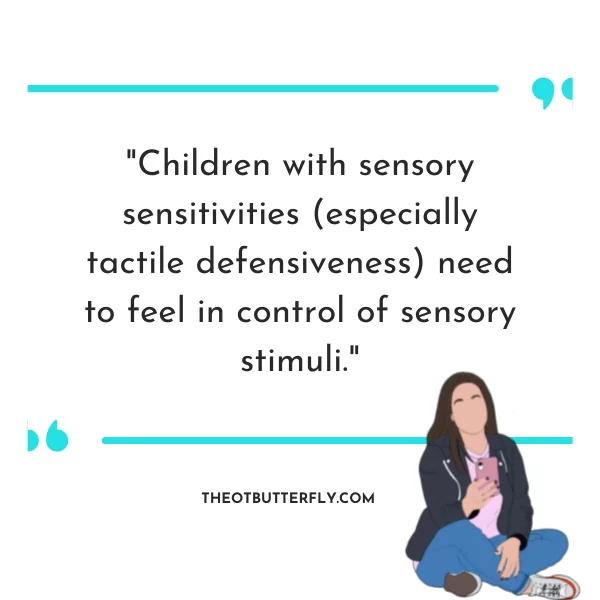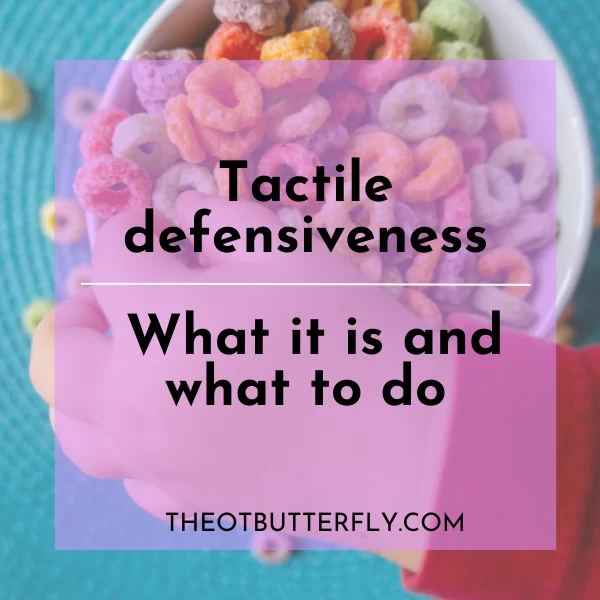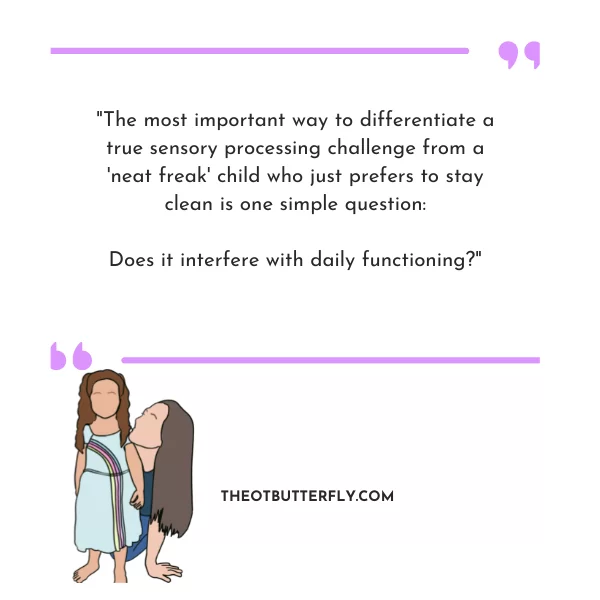Get your FREE sensory profiles cheat sheet >>click here<<
Tactile Defensiveness: What it is and what to do.
Tactile Defensiveness is fancy OT lingo for being hypersensitive to the touch sensation. People who experience tactile defensiveness have an extreme reaction to particular touch sensations/textures/feelings. These extreme reactions can hinder their ability to function in at least one major part (what we call “occupation” in OT) of their lives. They tend to respond in fight (aggression), flight (escape/avoid), or fright (freeze) to the stimuli.
How do I know if my child has a true tactile sensitivity or if they just don’t like messy play?
I get this question a lot, and I have actually asked myself this with my own daughter who, I believe, shows some early signs of tactile defensiveness. Parents and teachers want to know: when is it considered a sensory processing challenge (tactile defensiveness) and when is it just a “sensory quirk” that the child has?
The truth is, we all fall somewhere on the sensory spectrum. We all have our quirks. I get car sick and cannot handle loopy rides. But, it’s never affected my functioning (e.g. I don’t avoid car rides to the point where I’m isolated or can’t travel anywhere), so it’s not considered sensory processing disorder.
The most important way to differentiate a true sensory processing challenge from a “neat freak” child who just prefers to stay clean is one simple question:
Does it interfere with daily functioning?
Some examples of it interfering with functioning would include:
- not being able to participate in art at school
- not being able to eat at particular restaurants due to a sensory sensitivity
- not able to participate in social gatherings or activities that most peers are doing
- interfering with: grooming, hygiene, getting dressed, eating/feeding
What should I do if I notice signs of tactile defensiveness in my child?
So let’s say you check off some of those signs in the previous list. What should you do?
- Make a list of the specific sensory behaviors you notice with your child. Include lists of activities it interferes with, and how often it interferes
- Bring this list to discuss with your pediatrician and advocate for an OT referral. * I say advocate because some pediatricians take the “wait and see” approach too often. I end up seeing clients in the clinic at age 5 or 6 after they displayed signs of sensory processing challenges as early as 2 or 3, but their doctor didn’t refer until later.
- Get an OT evaluation.* If your child is younger than 3, there may be some services you are entitled to through your regional center. Ask your pediatrician for more information depending on your location.
Should I force my child to touch something?
NO! All sensory experiences should be facilitated by an adult (.e.g set up for the child, model how to explore it) but should remain child-led, playful, and within the child’s control.
NO! All sensory experiences should be facilitated by an adult (.e.g set up for the child, model how to explore it) but should remain child-led, playful, and within the child’s control.
You can check out how I like to encourage messy play with my own daughter who has some signs of tactile sensitivity in this post.
Children with sensory sensitivities (especially tactile defensiveness) need to feel in control of sensory stimuli. The moment they feel out of control or forced to try/touch something, a stress response is triggered and can reinforce the anxious feelings and aversive reactions they get from the activity.
You always want to leave a tactile exploration activity with the child feeling successful and confident, NOT fearful, anxious and stressed out.

For example, if the child is not ready to touch sand, you could model it a few times for them using limited contact (poking it with a finger). If they continue to refuse, offer them something to explore it with, like a stick. This would allow them to remain in the activity, but feeling in control and comfortable with playing.







